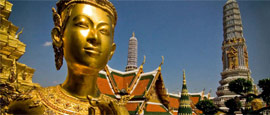A glittering walled complex that houses several palaces and temples, most ornately decorated with tiles and ceramics, the Grand Palace dates back to 1782 when Bangkok was founded as the new capital of Thailand.
The most important spot is Wat Phra Kaeo, the holiest of all Thai temples, where the sacred tiny Emerald Buddha rests – covered in jade, not emeralds. The rest of the complex houses a mix of Chinese gates, giant yaksha (demon) statues, pretty courtyards and a kilometre-long mural depicting scenes from the Hindu epic Ramayana. There is a strict dress code and visitors wearing shorts, mini-skirts, sleeveless shirts or flip-flops will need to hire trousers and plastic shoes at the entrance.








 You know where
You know where